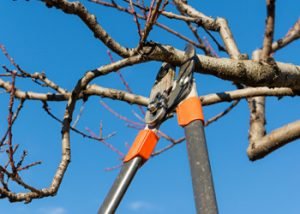Tree pruning is essential towards keeping your tree at maximum health. An unattended tree can become unhealthy in many ways: natural stubs can lead to rot and insects, suckers can sap the nutrition and energy from your tree, dead branches and overlapping branches can cause damage to the rest of the tree, and more.
To make sure your yard has the healthiest and happiest trees, you want to make sure you prune your tree at the right time, with the right techniques, and with the right equipment. Here’s everything you need to know for tree pruning 101:
Signs That It’s Time to Prune Your Tree

When is it time to best start your tree pruning? While late winter is always a safe option – right after the coldest weeks, and right before spring to promote your tree’s growth – there are a few other signs that show it’s time to prune your tree. These include:
- When branches have begun to sag lower than before. Sagging branches are signs of the tree becoming unhealthy and branches beginning to die
- Dead wood can be removed in the summer, as it is easier to notice when branches have no leaves
- After the branches have lost their leaves, as this makes it easier to prune for the sake of your tree’s form with highest visibility
Dealing With Different Parts of Your Tree

Not all trees end up naturally growing into the perfect Hollywood stock photo tree. Some trees need some help, with certain parts and pieces of the tree that can grow awkwardly. Here are those different parts and how to deal with them:
- Forked Trunks – When the base of a tree’s trunk seems to fork into two separate trunks, this leaves behind a space where rot and insects can grow to weaken the foundation of the tree. While your tree is still young, it’s important to remove the smaller trunk, by cutting it out as close to the ground as you can, with a slight downward angle. Do your best not to cause any damage on the other trunk.
- Broken Stubs – When you begin tree pruning, you might find some stubs on your tree from branches that broke off naturally from the wind. Stubs can be dangerous for your tree, as they make it difficult for the tree to grow a callus over the wound, leading to insects and rot seeping inside. To deal with this, cut the stub off right above the collar of the branch. This allows the tree to grow the protective callus over the wound properly.
- Clustered Branches – When many small branches become clustered together, this can inhibit the growth of your larger branches, while also damaging them and each other through physical contact. By cutting out these smaller, unsightly branches, you give your tree better airflow and sunlight.
Using The Right Equipment And Techniques

- Smaller Branches – Secateurs: Secateurs are the small, scissor-like devices with springs and a locking system. With gloves and safety glasses, go through your smaller branches and remove them with your secateurs.
- Medium Branches – Handsaw: The handsaw is ideal for medium branches, as it is easy to wield this medium-sized blade while dealing with lower branches that might be too thick for your secateurs. Remember: do not damage the main trunk while cutting, and try to remove branches at a downward angle pointed away from the trunk.
- Hard-to-Reach Branches – Pole Pruner: Some branches will be too high or above fences or roofs, making it difficult to access them directly. For these branches, you will need to use the lever action of your pole pruner. If the branches are too thick, acquire a saw pole pruner attachment to give yourself a hand.
- Thicker Branches – Loppers: Loppers are similar in shape and structure to secateurs, but much bigger. They have the size, strength, and length to reach and cut thicker branches on a tree.
While cutting these thicker branches, it’s essential that you tackle them from under the branch, not above. Cutting thick branches from the top will force the branch to snap off before the cut is done, leaving an unhealthy tear and mark in your tree that can lead to disease and insects.
Undercutting your branches involves sawing upwards from beneath the branch until you get just about halfway through the branch. Then saw from above until you cut directly through the branch.
Need Help? Call Us For Your Obligation-Free Tree Pruning Quote Today!

Tree pruning can be a difficult task, and making sure you get it done the right way is essential towards promoting maximum health in your tree. Our tree pruning experts at Aussie Tree Solutions have trimmed and pruned countless trees for almost four decades in the Brisbane area, and we’d be more than happy to give you a hand with your tree today.
Give us a call and ask for your obligation-free tree pruning quote today. Your tree will never be healthier and safer than in the hands of Aussie Tree Solutions!
*All tree work should be done in accordance to local council regulations. Before conducting any tree work please contact either your local council or tree specialists for the latest regulations. Aussie Tree Solutions are professional tree removal, pruning and maintenance experts. For any questions relating these services, please call Aussie Tree Solutions on 07 3351 1722.

